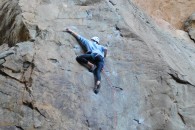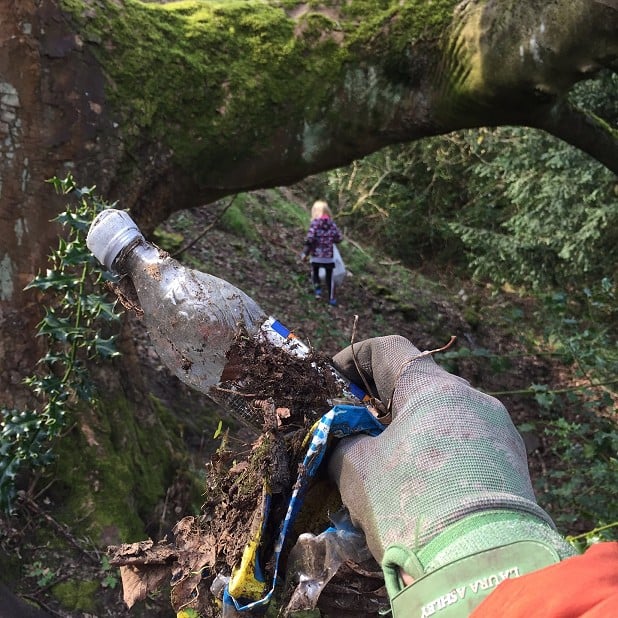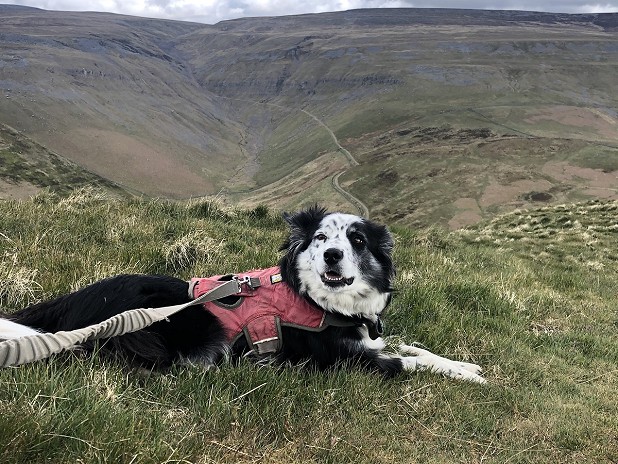Environmental Etiquette - the dos and don'ts on hills and crags
From fires and litter to traffic and transport, Carla Broom examines the ways that walkers and climbers can minimise their impact at a time when our beauty spots have never been busier.
As climbers and walkers, we are naturally outdoorsy people and we'd like to think we have a strong connection to our environment, meaning that many of us make the effort to be environmentally conscious. Now that normality is on the horizon and adventures are within grasp, it's more important than ever to make sure we look after our planet while we're out and about, especially with the likely explosion in countryside visitors, campers and camper vans as travel restrictions ease and people return en masse to the outdoors.
So we've put together a few tips on best practice when out and about in nature. Rule number one of environmental etiquette – leave no trace and leave a place exactly as you found it, or better.
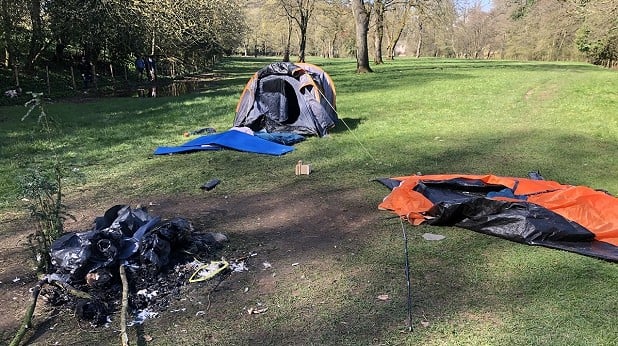
Campfires and BBQs
Ill-tended campfires and barbecues can lead to wildfires, especially when it's been dry for a long time in spring and summer. Very few wildfires occur naturally, most are accidental or are set on purpose – and they destroy habitat and important ecosystems. In June 2020, fire crews extinguished over 30 unattended BBQs at Studland Bay in one night, and that is just one example of many hundreds every year.
The easiest way to avoid this is simply not to light campfires. Even in areas they are technically allowed, and even if you put them out properly, they still leave burn marks on the floor and destroy the vegetation, which definitely leaves a trace. There's also the question of where to get the wood from – removing it from the forest takes away vital resources and nutrients provided by deadwood, and cutting down trees to obtain wood is a big no-no (besides which, green wood barely burns). If you need to cook, then bring a camping stove.

Disposable barbecues are also a big issue in the countryside. If they are placed on bricks or rocks it may be possible to avoid burning the ground underneath, but avoid at all costs scorching bare ground which is at best unsightly and at worst a wildfire risk. BBQs must be properly put out with water or sand, and completely cooled before taking home for disposal – which could take a few hours. Always keep water nearby or keep a fire extinguisher in your vehicle in case there's an emergency, and never leave a BBQ unattended. Make sure it's in a safe area, away from vegetation, and fundamentally only use them where they are allowed. Bearing all that in mind, it is arguably sensible to avoid having barbecues out in the countryside altogether. Save them for the back garden.
Other ways to avoid accidentally sparking a wildfire include picking up your glass bottles because these can catch the sunlight and start fires, and putting out cigarettes properly and not throwing them on the floor. You can get portable ashtrays to keep butts in until you find a bin.
Litter
Amazingly, some people still think it's OK to just throw their rubbish on the floor. As well as BBQs and cigarettes (filters contain plastic and tobacco contains many contaminants), the three major litter culprits are food packaging, confectionery wrappers and drinks bottles made from plastic, aluminium, or glass. Not only does it look ugly, litter harms wildlife. Small mammals like voles, mice and hedgehogs can get stuck in bottles, and they can choke on ring pulls from cans. Plastic doesn't degrade – it just breaks into smaller pieces called microplastics which are found everywhere and enter the food chain.
It is thought that around 80% of the litter in the ocean comes from the land, especially around coastal areas. Plastic in the ocean is just as bad, if not worse – 100 million marine mammals (dolphins, whales, porpoises and seals) die every year from plastic pollution.
Microplastics in the ocean are also ingested by lots of animals like fish, and when we eat them, the plastics end up inside us. They can accumulate over time and release toxins which are definitely not good for ecosystems or humans.
The answer is simple – take all your little home with you for proper disposal. Regardless of who is actually to blame, visitors to the countryside have gained a bad reputation over the last year for leaving areas covered in litter. To help improve that image we walkers and climbers might consider taking part in local litter picks. Either do your own, or look out for organised cleans, for example with the Lulworth Rangers and on the Wild Campers Against Waste page. Even if it's not an organised pick, it's always worth bringing a bin bag to collect other people's rubbish when you're out and about. And spread the word - if you see someone littering, politely ask them to pick it up!
Human waste
We all need to poo, and sometimes nature calls in very inconvenient places. 70% of walkers say they urinate in public, and 44% have defecated. However, only 15% of these buried their poo and only 3% picked it up to dispose of it – so what happened to the rest of it? The problem is largely one of ignorance.
We don't want to leave our faeces lying around for someone to find, and we don't want to stumble upon someone else's while walking, so make sure you dispose of it properly. It biodegrades a lot better if it's buried, 15cm or so is fine, so if you're a regular nature pooper carry a trowel with you just in case. It also degrades better at lower altitudes, so try to go at the bottom of the mountain, not at the top!
Avoid footpaths or anywhere that humans might find it, so stray away from the path most travelled and into the woods. Also stay at least 30m away from water, to avoid any contaminants accidentally ending up in a stream or lake. Nobody wants their water tainted with bacteria associated with human waste.
Once you've cleaned up, you need to dispose of the toilet paper, not just throw it in a bush. Carry a bin bag with you, or if it's safe to do so, you can burn it - but be very wary about doing this, especially in dry conditions. Take any nappies and sanitary wear with you as well.
To be the best poo-er you can be, carry these things with you when you're out and about: toilet paper, lighter, poo/tissue bags, a trowel, and some hand sanitiser.
Footpaths
Popular areas that attract many visitors experience a lot of footpath erosion. Areas with good vegetation cover have lots of roots that bind the soil together and keep it stable – but as people walk across it, the soil compacts and reduces the infiltration of rainwater, which forms a gully. Water will run overland instead of soaking into the soil, washing away soil particles. As more people walk across it, vegetation is also destroyed, so there are fewer roots, and more soil is washed and blown away. The gully deepens, acting as a channel for running water, and eventually the underlying rock is exposed.
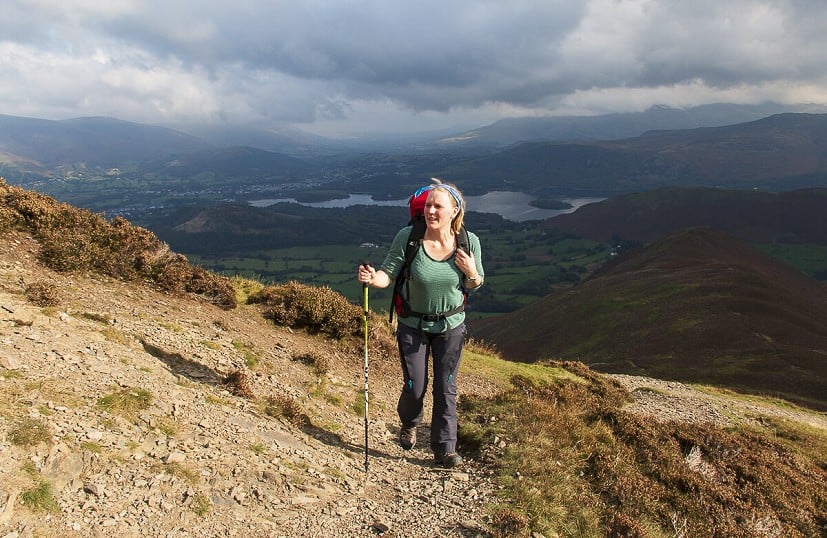
This isn't very pleasant to walk on, and can cause injury through falls or twisted ankles – we've probably all gone flying after tripping over an exposed tree root. This means people tend to walk on the grass next to the path, but then the process just repeats itself and widens the footpath over time. This effect is increased on slopes, and since most of our walks go up and down hills, it's something we need to be wary of.
Always stick to the footpath when you can, for instance not cutting corners, and if it's severely degraded report it to the local authorities so that they might carry out some restorative work. By sticking to the footpaths, we also avoid destroying habitat and damaging vegetation and rare plants that might be growing nearby. Never pick a plant unless you know what it is – it might be a rare species trying to thrive.
Parking
As we return to the outdoors in our millions, parking is becoming an absolute nightmare, so it's important to remember to park respectfully. Respect local communities by using designating car parks and parking areas, and don't block gates, passing places or driveways. Leave enough room for other vehicles to get past, like emergency vehicles, delivery trucks and tractors. People will not be happy if we're blocking their access, and if landowners get angry they can easily restrict land access – especially a consideration bearing in mind the Government's proposed new trespass laws in England.
If you're at a crag, the guidebook will outline parking options, and UKC, the BMC or Mountaineering Scotland may also have updated parking information. If a car park is full, either park further or away or go somewhere else – we don't want to overcrowd beauty spots or cause congestion issues so bad that drastic measures end up being taken that limit our enjoyment of a place in future.
Camping and Vans
Dirtbag climbers might have been doing it for years, but these days van life is a trend embraced by everyone from hipsters showing off their self conversions on social media, to wealthy retirees in motorhomes costing more than a small house. The recent surge in the popularity of camper vans has brought to a head a number of issues including congested roads, permanently full laybys and car parks, littering and wild toileting.
People are starting to get very annoyed at roadside wild campers, too, pointing to the problems of waste, fires and anti social behaviour. While there is no doubt that the actions of a thoughtless contingent are reflecting badly, and unfairly, on those of us who have been camping with minimal impact for decades, the only way to avoid problems for everyone is to stick to some simple rules.
Firstly, know the laws behind what you're doing. Wild camping is technically illegal in England and Wales, except for some delineated areas of Dartmoor, but it is legal in Scotland. Sleeping in a vehicle is legal (at the time of writing), so long as you're not blocking an entrance or intending to claim the land.
If you are going to pitch a tent in nature, make sure you're out of sight and far from roads and houses, out in the woods or up in the hills. If you're in the middle of nowhere you might get away with staying for a couple of nights, but in busy areas make sure you're only pitching a tent between dusk and dawn. In a van, make sure you arrive late and leave early, and don't set up camp for days on end – especially not on the side of a busy road, in full view. Doing so is just plain provocative.
If you arrive at a layby to find lots of people there already, leave and go somewhere else. Last summer, popular spots like the Lake District and the Scottish Highlands were jam-packed with vans and wild campers, and the locals were justifiably unhappy about it. In peak season, take your holiday somewhere other than these popular areas, as the parking is likely to be busy anyway and the traffic will be awful.
Lastly, stay in small groups. Large groups create a lot of noise and a lot of disturbance. All the things I've mentioned before also apply; park considerately, don't litter, don't have fires, and dispose of your poo properly.
Transport
We all know that the public transport situation in this country isn't ideal, but with the rise in the number of cars on the road, the traffic, the parking spots, and the atmosphere could really do without more driving. The biggest threat to clean air is transport-related emissions, so we should try to use public transport or bikes when we can.
A lot of beautiful areas are out of the realm of trains and local buses, but with some dedication it's surprising how far out you can get:
And sharing cars (once we're allowed to mingle!) or getting a lift for the last leg of the journey can really make a difference. Meanwhile, if you're prepared to put in some time and effort, you can get anywhere by bike (though perhaps not while transporting a boulder pad).
Avoid overcrowding
From the Scottish Highlands to the South Coast, if last year's relaxation of lockdown is anything to go by, popular beauty spots and honeypots are likely to be very crowded this spring and summer. Given the ongoing pandemic situation, the distancing issue could get stressful, and it would be unfortunate if walkers and climbers got a bad name for congregating at busy spots. Of course, if you join the crowd then you will be part of the problem.
The busier an area, the worse the parking situation, the more litter and the more erosion occurs, harming the environment. If the obvious places are already likely to be busy, then just go somewhere else. The hidden, less well-known spots are often the more beautiful ones anyway. Just hope your preferred destination hasn't already started trending on Instagram!
Dogs
If you have a canine companion, make sure you bury or pick up its poo with a doggy bag, and put it in the bin (who leaves theirs hanging from branches, for someone else to deal with? One of life's mysteries).
Even if your pooch is well behaved, keep it on a lead around livestock. They're animals too, and they get stressed out if they're pestered by dogs. Scaring sheep around lambing time can lead to lambs being lost, and some dogs do a lot more than just pester. If your dog is worrying livestock, the farmer has the legal right to shoot it if it's on their land.
Wildlife in important habitats such as heathlands can be affected by dogs off the lead. Ground nesting birds are disturbed by dogs coming over for a sniff, and if the bird abandons the nest her brood can be lost. Many ground nesting birds are classified as rare species and their habitats are prone to disturbance, so it's really important that we don't make life more difficult for them. Every year, there are multiple reports of dogs being bitten by adders, our only venomous snake - if a huge dog came and disturbed your nest, you'd probably bite it too! There's a simple way to avoid all of this: keep them on a lead.
Best practise at the crag
Chalk
Most of us use chalk while we're climbing, but the substance we use is not normal blackboard chalk - it's magnesium carbonate, which is extracted from magnesite which comes from mining. This leaves scars across the landscape and leaves harmful dust which forms a hard shell and has been linked to plant death and soil degradation.
While climbing chalk makes up a small amount of magnesite's use, it's important that we know where our chalk comes from – but sadly, most companies do not disclose this information, and most of them probably don't know. To be truly eco-friendly, we should demand transparency in the supply chain, as everyone should know where their products are coming from.
Chalk also affects the rock itself – porous rock like sandstone and limestone can absorb chalk, leaving ugly blemishes behind and ruining the beta for the next excited climber. Use chalk sparingly. Invest in a sof brush if you haven't already, and remove your tick marks and handprints when you finish a climb.
Nesting birds
Climbing at certain crags is banned during some months due to birds nesting in the rocks, but this information is not always advertised at the crag itself. Make sure you check the BMC nesting bird guide, or other local equivalent, before climbing to make sure your chosen crag is not restricted. If a bird is scared away from the nest while it is incubating eggs, the eggs can cool down very quickly and prevent the chick from developing properly, or even kill them, so we don't want to disturb the birds during this sensitive time.
Even if access isn't restricted, use common sense and your own judgement. If you see birds flying into the rock to feed their young, or see chicks or eggs in a nest, avoid that climb or that area. If birds start alarm calling, circling the nest in agitation or even dive bombing you, get out of there and leave the poor birds alone! It's their rock too.
Walls and fences
Lastly: don't climb or jump over walls and fences. Both are easily damaged. This is especially important for drystone walls - since they're not held together with mortar, they are easily dislodged, angering landowners and destroying habitat for the insects and small animals that nest within the stones.
